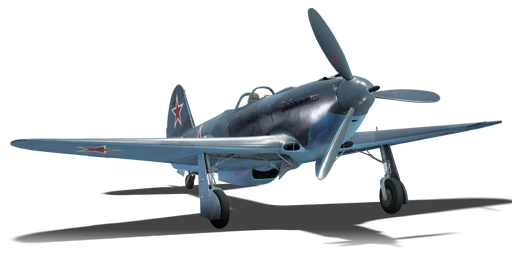

Aviation
Yak-3T
IV
Rank
AB
5.3
RB
5.0
SB
5.7
Battle rating
USSR
Research country
Fighter
Main role

Premium vehicle
Status
General information
Flight performance
Max speed
at 4,200 m
646606666625 km/h
Rate of Climb
21.117.823.917.8 m/s
Turn time
18.920.418.119.8 s
Max altitude
10,400 m
Takeoff Run
360 m
Landing
flaps
flaps
Take-off
flaps
flaps
Combat
flaps
flaps
Air
brake
brake
General characteristics
Crew
1 person
Engine
Length
8.5 m
Wingspan
9.2 m
Wing Loading
184 kg/m²
Weight:
Base weight
2.472.552.412.53 t
Fuel in main tanks
0.26 t (46m)
Limits:
Max Speed Limit (IAS)
685 km/h
Mach Number Limit
0.73 M
G limit
≈ -9/12 G
Flap Speed Limit (IAS)
320 km/h
Gear Speed Limit (IAS)
320 km/h
Offensive armament
37 mm N-37 cannon
Ammunition
25 rounds
Fire rate
400 shots/min
One-second Burst Mass
4.96 kg
| Belt | Belt filling | Armor penetration (mm) at a distance: | |||||
|---|---|---|---|---|---|---|---|
| 10 m | 100 m | 500 m | 1000 m | 1500 m | 2000 m | ||
| HEFI-T/HEFI-T/API-T | 49 | 47 | 39 | 32 | 26 | 21 | |
| HEFI-T/HEF-I/HEF-I | 6 | 6 | 5 | 4 | 3 | 3 | |
| API-T | 49 | 47 | 39 | 32 | 26 | 21 | |
2 × 20 mm B-20S cannon
Ammunition
200 rounds
Fire rate
750 shots/min
One-second Burst Mass
1.21 kg
| Belt | Belt filling | Armor penetration (mm) at a distance: | |||||
|---|---|---|---|---|---|---|---|
| 10 m | 100 m | 500 m | 1000 m | 1500 m | 2000 m | ||
| FI-T/AP-I | 28 | 24 | 14 | 7 | 4 | 2 | |
| FI-T/HEF/AP-I/FI-T | 28 | 24 | 14 | 7 | 4 | 2 | |
| HEF/FI-T/AP-I | 28 | 24 | 14 | 7 | 4 | 2 | |
| FI-T/FI-T/FI-T | 4 | 4 | 4 | 4 | 4 | 4 | |
| AP-I/FI-T/AP-I/AP-I | 28 | 24 | 14 | 7 | 4 | 2 | |
| AP-I/HEF/HEF/FI | 28 | 24 | 14 | 7 | 4 | 2 | |
Economy
Repair cost
AB
1,395 

RB
4,937 

SB
9,490 

Crew training
10,000 

Experts
250,000 

Aces
820 

Research Aces
870,000 

Reward multiplier
AB / RB / SB
 2 x (85 / 225 / 405) %
2 x (85 / 225 / 405) % 
 2 x 160 %
2 x 160 % 

Premium vehicle
All modifications are unlocked
Flight performance | |
|---|---|
Survivability |
|---|
Weaponry |
|---|
Rating by players
You must play more than 3 battles for the last week and more than 10 battles in a vehicle to rate it.
Like:
26
Flight performance:
Not enough ratings
Survivability:
Not enough ratings
Aerial combat:
Not enough ratings
Ground attack:
Not enough ratings
Balance:
Not enough ratings
Tips & Tricks
This space is currently empty
Do you know any interesting vehicle features?
Loading...
No articles about this vehicle yet
Become the first author and get rewards!
Write a guide, tell about interesting historical facts, make a tutorial or simply an interesting post.
No more content